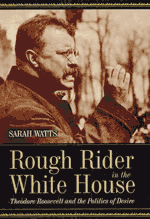"Sarah Watts promises readers a wild ride in her new study of Theodore Roosevelt. She delivers that and more. Delving deeply into his writings and the culture of his time, Watts finds connections other historians have missed. Original and perceptive, Rough Rider in the White House will make people think twice about a key American icon."—Kathleen Dalton, author of Theodore Roosevelt: A Strenuous Life
"What else is there to say about Theodore Roosevelt? Quite a lot, actually, as Sarah Watts demonstrates in this provocative and venturesome new work. Addressing the long-standing suspicion that Roosevelt's obsession with masculinity was connected to his policies, Watts comes up with some brilliant insights through the course of her search for the roots of his character. Taking the reader on a journey to the depths of his psyche, Watts ultimately illuminates the connections between Roosevelt's body and the body politic in ways that give new meaning to the idea that he was an embodiment of the nation."—Frank Ninkovich, author of The United States and Imperialism
An excerpt from
Rough Rider
in the White House
Theodore Roosevelt and the Politics of Desire
by Sarah Watts
Cowboy Soldiers
Is America a weakling to shrink from the world-work?
—Theodore Roosevelt, to the 1900 Republican National Convention
I owe more than I can ever express to the West.
—Theodore Roosevelt, "In Cowboy Land"
For those men at the turn of the century who were psychologically ripe for models of essential masculinity, Roosevelt almost single-handedly caused a "sudden, radical shift," Theodore Greene argues, in the American hero model. "It was one of those utterly unthinkable coincidences," William Allen White, the Kansas editor, remarked, "that a man of Roosevelt's enormous energy should come to the Presidency of exactly that country which at exactly that time was going through a transitional period—critical, dangerous, and but for him terrible." Roosevelt emerged as a central purveyor of the cowboy-soldier hero model because he more than any man of his age harnessed the tantalizing freedom of cowboys to address the social and psychological needs that arose from deep personal sources of frustration, anxiety, and fear. More than any other he sensed that ordinary men needed a clearly recognizable and easily appropriated hero who enacted themes about the body; the need for extremity, pain, and sacrifice; and the desire to exclude some men and bond with others. In one seamless cowboy-soldier-statesman-hero life, Roosevelt crafted the cowboy ethos consciously and lived it zealously, providing men an image and a fantasy enlisted in service to the race-nation.
Rather than creating the new archetype, Roosevelt accelerated and focused several cultural themes that converged in it. As we have noted, men were changing their ideas of how to be men, appropriating more aggressive models in response to a growing sense of male diminishment. The republican heroes of antebellum America, Greene found by studying elite magazines, consisted largely of those gentlemen, scholars, and patriots whose reputations rested less on their wealth than on evidence of their character—honesty, sobriety, hard work, and civic service. By century's end these heroes had been joined by Daniel Boone, Leatherstocking, and Civil War generals, but while all remained enormously popular, they somehow fell short in providing what was needed in a specifically modern hero. In keeping with changing models of masculinity, Greene says, mass-circulation magazines began to feature a Napoleonic "idol of power," a man of action who used iron will and "animal magnetism" to crush his rivals and dominate nature. Biographers of plutocrats and robber barons encouraged readers to envision themselves in a social Darwinist world of ruthless competition where character alone appeared effeminate and sentimentalism dangerous. Earlier notions of manliness had counseled reason over passion; now the hero must unleash his "forcefulness."
Enter a new type of charismatic male personality after 1870, a cowboy-soldier operating in the new venue of the American West on sheer strength of will and physicality. Eastern readers instantly recognized him as more masculine precisely because he met the psychological desires in their imagination, making them into masters of their own fate, propelling them into violent adventure and comradeship, believing them at home in nature, not in the hothouse interiors of office buildings or middle-class homes. Writers pitched the cowboy ethos against Christian values of mercy, empathy, love, and forgiveness, against domestic responsibility and the job demands that complicated men's lives and dissolved their masculine will. The cowboy was not interested in saving souls or finding spiritual purity or assigning meaning to death. His code of conduct arose as he struggled against the overwhelming wildness of men and beasts and carved out a prairie existence with guns, ropes, and barbed wire. Readers suspended ordinary morality as they fantasized about life at the margins of civilization and sampled forbidden pleasures of taming, busting, subduing, shooting, hanging, and killing.
The cowboy cult drew on other important cultural themes as well. Its racial component arose in part from developing notions of national unity that began to overcome Civil War sectionalism. As industrial society's racial and class tensions grew and war wounds healed, Nina Silber finds, Northerners adopted a more sympathetic view of Southern white manhood, one in which Southern elites came to be admired for their racial acumen. Northerners abandoned critical views of slavery for nostalgic reminiscences of plantation life in which white Southern men had effectively managed a racial society, keeping blacks where they belonged and protecting white women's virtue. In the theaters, novels, and traveling shows of the 1890s, popular themes of happy plantation slaves reflected Northern acceptance of the Southern white view of race and the Jim Crow limitations on suffrage, mobility, education, and economic life. Even if many, though not all, Northerners drew the line at excusing lynching, Silber observes, they nevertheless accepted the idea that Southern white men lynched black "rapists" in the attempt to prove themselves men. Concerns about protecting Southern womanhood reflected Northern men's anxieties about promiscuous sexual behavior and the preservation of women's proper sphere. Finding a common ground of white manliness among former enemies, Silber explains, helped Northern whites to "cast African-Americans outside the boundaries of their Anglo-Saxon nation," to romanticize Southern notions of chivalry, and to justify turning Southern race relations over to Southern whites entirely.
Northerners drew racialized bonds of white brotherhood around men so recently considered traitors by conjuring an abstracted, essentialized white manhood untainted by sectional or class divisions. In the 1890s, the appearance of Flag Day and veterans commemorations and organizations like the Daughters of the American Revolution emphasized sectional harmony and elevated a new form of nationalism based not on identifiable values, but on an empty and exceedingly blind loyalty. In an 1895 Memorial Day speech, "The Soldier's Faith," given at Harvard's Soldier's Field, a football arena named in honor of six of the school's Civil War dead, Oliver Wendell Holmes Jr. best expressed this new patriotism: "The faith is true and adorable which leads a soldier to throw away his life in obedience to a blindly accepted duty, a cause in which he little understands." Such logic, which placed unthinking dutifulness over understanding, left little room for moral discretion and made blind response a virtue. Such martial abstractions rallied many men, patriotic speakers knew. In the installation ceremony for the General William Tecumseh Sherman monument in Washington, D.C., Roosevelt honored the "valor and devotion to duty" of former Confederate as well as Union veterans, for the Confederate soldiers had merely responded to a "loyalty toward what they regarded as right."
These abstractions suited well both the demands of national unity and the myth of the cowboy as a loner true to his own code of honor. The cowboy style of manliness drew on the antebellum notion that white men possessed the core, essential quality that Melville's Ishmael detected in Starbuck, the Pequod's first mate, who radiated "that immaculate manliness we feel within ourselves, so far within us, that it remains intact though all the outer character seems gone." Toward century's end, Mark Twain, one of Roosevelt's favorite interpreters of the American West, identified this essence in the "magnificent, glorious giants" who tamed the American frontier:
It was a driving, vigorous, restless population in those days. . . . It was the only population of the kind that the world has even seen gathered together. . . . For, observe, it was an assemblage of two hundred thousand young men—not simpering, dainty, kid-gloved weaklings, but stalwart, muscular, dauntless young braves, brimful of push and energy, and royally endowed with every attribute that goes to make up a peerless and magnificent manhood—the very pick and choice of the world's glorious ones. No women, no children, no gray and stooping veterans—none but erect, bright-eyed, quick-moving, strong-handed young giants—the strangest population, the finest population, the most gallant host that ever rode down the startled solitudes of an unpeopled land.
In Twain's heroes, it was not virtuous character or principled action but a forceful physicality, totally male and forever young, that primed his idealized giants to ride over smaller beings and virgin landscapes, doing what Roosevelt later called the "world-work" of soldier statesmen. Jacob Riis, only one among many who avowed that Roosevelt embodied in real life the masculine essence Melville and Twain expressed in literature, predicted that America "shall make of [Roosevelt] a king in his own right, by his undimmed manhood," In depicting a "royally endowed," "immaculate," and "peerless and magnificent" manhood, Melville, Twain, and Riis uncovered an essentialism born of a desire for an aristocratic, exclusionary yet unifying, purified strongman. "If this sounds like a prescription for Theodore Roosevelt," Greene points out, "it was."
The Crafted Cowboy
 Figure 24. Roosevelt in Leatherstocking costume, c. 1883–84 (Library of Congress Prints and Photographs Division, Washington D.C., 215922 LCUSZ6 24172 3) Larger image |
At age twenty-five, on his first trip to the Dakota badlands in 1883, Roosevelt purchased a ranch, bought a herd of cattle, hired ranch hands, and, spending considerable time there, began to develop his Western image. He took "obvious delight," his younger cousin Nicholas observed, in the "apparently pathological extremes" of his exploits in the Dakotas—"rides of seventy miles or more in a day, hunting hikes of fourteen to sixteen hours, stretches in the saddle in roundups of as long as forty hours." During his early years as a ranchman, Roosevelt's appearance, in studio photos at least, suggested a Leatherstocking frontiersman of the eighteenth-century Appalachian wilderness. In 1883 or 1884, he posed in a fringed buckskin outfit, complete with hunting cap, moccasins, cartridge belt, silver dagger, and rifle (figure 24). Yet without Western attire, a horse, or an open prairie, he still looked like an Eastern would-be.
 Figure 25. Roosevelt c. 1885 (Theodore Roosevelt Collection, Harvard College Library) Larger image |
During his time in the Dakotas, Roosevelt hardened his body, a task, Nicholas remembered, that was not completed "to his satisfaction" until his late twenties. Roosevelt's struggles against cattle thieves and lawless gangs and his skill in breaking and riding wild cow ponies provided the physical courage "which his soul had aspired to in boyhood," William Roscoe Thayer observed. His asthma abated, and finally he developed a body "which could back up any resolution he might take." "I am well hardened now," Roosevelt wrote to his sister Anna in 1884; "I have just come in from spending thirteen hours in the saddle."
 Figure 26. Roosevelt as cowboy in the Dakota Territory (Theodore Roosevelt Collection, Harvard College Library) Larger image |
As Roosevelt's cowboy image evolved, his popular image changed along with it. When he bought his first ranch, both Westerners and the Eastern press ridiculed him for looking like an overdressed, overeducated tenderfoot. By 1886, his Western exploits had visibly hardened him. "What a change!" the Pittsburgh Dispatch exclaimed; "he is now brown as a berry and has increased 30 pounds in weight." His high and squeaky voice was now "hearty and strong enough to drive oxen." Reviewers of Hunting Trips of a Ranchman: Ranch Life and the Hunting Trail (1888) and The Wilderness Hunter (1893) allowed Roosevelt the full legitimacy of Western cowboy life. The New York Times certified that "Mr. Roosevelt has had full practical experience of what he writes about" and noted that "to be a cowboy . . . is by no means an easy task." Ranching life held "a special charm for the gilded youth of the Eastern states," The Dial's reviewer reported, "and Mr. Roosevelt seems to have followed it."
It was not just how a cowboy looked that separated him from Easterners, but how he lived. In their struggle against nature, the New York Tribune noted, cowboys had to live lives of "intelligent barbarism" that involved "barbarous and crude forms of dissipation." "I heartily enjoy this life, with its perfect freedom," Roosevelt wrote, "for I am very fond of hunting, and there are few sensations I prefer to that of galloping over these rolling, limitless prairies, rifle in hand." "He craved once more to be alone with nature," reported the naturalist John Burroughs; "he was evidently hungry for the wild and aboriginal,—a hunger that seems to come upon him regularly at least once a year, and drives him forth on his hunting trips for big game in the West." In this intense contact with a heightened reality, Roosevelt claimed to have discovered the raw and primitive man in himself—what Easterners must have been like before being drained of their life juices. "This is what I was like when I had the bark on," he later wrote.
 Figure 27. Thomas Nast, "A Popular View of the Commissioner's Victory over the Spoils System," 1889 (Theodore Roosevelt Association) Larger image |
Thomas Nast was one of the nation's first image makers to transport Roosevelt's cowboy body into the nation's political culture. In a cartoon of 1889, the first year Roosevelt served as the U.S. civil service commissioner in Benjamin Harrison's administration, Nast blended Roosevelt's Wild West bronco busting with current notions of progressive reform (figure 27). In this remarkably predictive portrayal, a youthful and determined cowboy at "Uncle Sam's Ranch," disciplines the out-of-control "Spoilsman" with "Civil Service Reform." During the following six years, Roosevelt gained national attention by removing thousands of jobs from political patronage, thus making civil service reform a popular cause. This move surprised the Republican party machine and provoked the unenthusiastic Harrison to remark that Roosevelt "wanted to put an end to all the evil in the world between sunrise and sunset."
 Figure 28. "Col. Theodore Roosevelt, of the Rough Riders," 1898 (© Underwood & Underwood) Larger image |
After serving as governor of New York and McKinley's vice president, Roosevelt became president in 1901. Punch commemorated the ascent of the nation's favorite cowboy to the highest office. Sending its "best wishes," the magazine pictured the Rough Rider, complete with an American flag saddle blanket, reporting for duty as president of the United States (figure 29).
 Figure 29. Bernard Partridge, "The Rough Rider," Punch, 25 September 1901 Larger image |
Copyright notice: Excerpted from pages 123-35 of Rough Rider in the White House: Theodore Roosevelt and the Politics of Desire by Sarah Watts, published by the University of Chicago Press. ©2003 by The University of Chicago. All rights reserved. This text may be used and shared in accordance with the fair-use provisions of U.S. copyright law, and it may be archived and redistributed in electronic form, provided that this entire notice, including copyright information, is carried and provided that the University of Chicago Press is notified and no fee is charged for access. Archiving, redistribution, or republication of this text on other terms, in any medium, requires the consent of the University of Chicago Press.
Sarah Watts
Rough Rider in the White House: Theodore Roosevelt and the Politics of Desire
©2003, 300 pages, 57 halftones
Cloth $40.00 ISBN: 978-0-226-87607-8
Paper $20.00 ISBN: 978-0-226-87609-2For information on purchasing the book—from bookstores or here online—please go to the webpage for Rough Rider in the White House.
See also:
- Our catalog of books in history
- Our catalog of books in biography
- Other excerpts and online features from University of Chicago Press titles
- Sign up for e-mail notification of new books in this and other subjects
